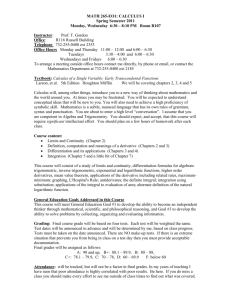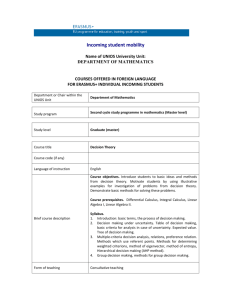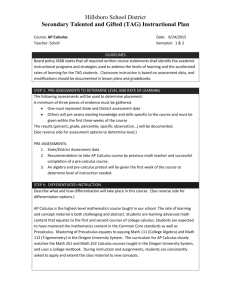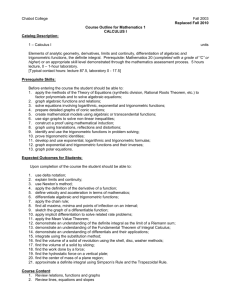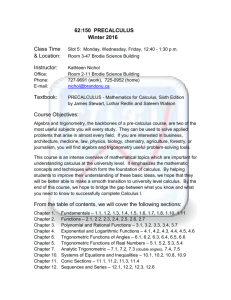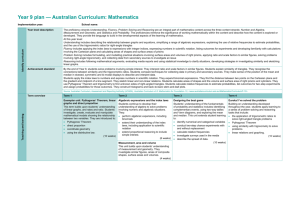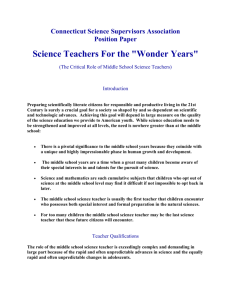Standards – Based Instructional Unit
advertisement
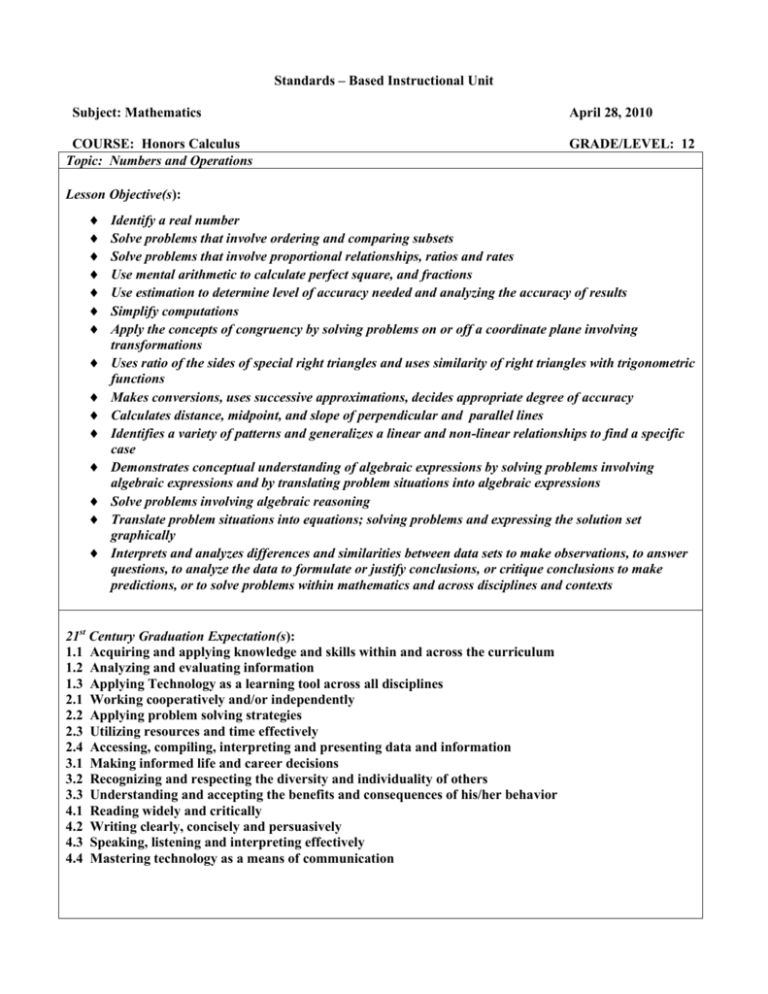
Standards – Based Instructional Unit Subject: Mathematics COURSE: Honors Calculus Topic: Numbers and Operations April 28, 2010 GRADE/LEVEL: 12 Lesson Objective(s): Identify a real number Solve problems that involve ordering and comparing subsets Solve problems that involve proportional relationships, ratios and rates Use mental arithmetic to calculate perfect square, and fractions Use estimation to determine level of accuracy needed and analyzing the accuracy of results Simplify computations Apply the concepts of congruency by solving problems on or off a coordinate plane involving transformations Uses ratio of the sides of special right triangles and uses similarity of right triangles with trigonometric functions Makes conversions, uses successive approximations, decides appropriate degree of accuracy Calculates distance, midpoint, and slope of perpendicular and parallel lines Identifies a variety of patterns and generalizes a linear and non-linear relationships to find a specific case Demonstrates conceptual understanding of algebraic expressions by solving problems involving algebraic expressions and by translating problem situations into algebraic expressions Solve problems involving algebraic reasoning Translate problem situations into equations; solving problems and expressing the solution set graphically Interprets and analyzes differences and similarities between data sets to make observations, to answer questions, to analyze the data to formulate or justify conclusions, or critique conclusions to make predictions, or to solve problems within mathematics and across disciplines and contexts 21st Century Graduation Expectation(s): 1.1 Acquiring and applying knowledge and skills within and across the curriculum 1.2 Analyzing and evaluating information 1.3 Applying Technology as a learning tool across all disciplines 2.1 Working cooperatively and/or independently 2.2 Applying problem solving strategies 2.3 Utilizing resources and time effectively 2.4 Accessing, compiling, interpreting and presenting data and information 3.1 Making informed life and career decisions 3.2 Recognizing and respecting the diversity and individuality of others 3.3 Understanding and accepting the benefits and consequences of his/her behavior 4.1 Reading widely and critically 4.2 Writing clearly, concisely and persuasively 4.3 Speaking, listening and interpreting effectively 4.4 Mastering technology as a means of communication Standards: Students should: develop a deeper understanding of very large and very small numbers and of various representations of them; compare and contrast the properties of numbers and number systems, including the rational and real numbers, and understand complex numbers as solutions to quadratic equations that do not have real solutions; judge the effects of such operations as multiplication, division, and computing powers and roots on the magnitudes of quantities; develop fluency in operations with real numbers; judge the reasonableness o f numerical computations and their results GSES: M(N&O)4 Solving Problems M(N&O)6 Mental Computation M(N&O)7 Estimation M(N&O)8 Properties of Numbers M(G&M)4 Concepts of Congruency M(G&M)5 Concepts of Similarity M(G&M)7 Uses Units of Measure M(F&A)1 Patterns M(F&A)2 Linear & Nonlinear Functions M(F&A)3 Algebraic Equations M(F&A)4 Equality R 10-3 Breadth of Vocabulary Knowledge R 10-7 Analyzing Informational Text W-10-1 Structures of Language W-10-2 Response to Text W-10-8 Informational Writing W-10-9 Writing Conventions *Calculus is an advanced mathematics course that exceeds the mathematics covered in the GSEs. Reading Students will use vocabulary strategies to identify context data. Students will read the text for understanding. Students will organize information to show understanding. Writing Students will summarize responses. Students will demonstrate informational writing. Problem Solving Students will compare and contrast graphs. Students will work backwards. Students will write a number sentence/formula. Students will use a model. Students will look for a pattern. Students will make and test conjectures. Students will construct and present valid arguments. Essential Question(s): Using a mathematical model, calculate the Instantaneous rate of change as the limit of average rate of change. Using a mathematical model, calculate the Approximate rate of change from graphs and tables of values. How can one design a mathematical model to inform and solve a practical or abstract situation? Content Topics: Limits Differentiation Integration Logarithmic, Exponential, and Other Transcendental Functions Student-Centered Instructional Strategies: Graphing Calculator Differentiated instruction Pre-Assessment Student-Centered Learning Tasks and Opportunities: Cooperative learning Manipulatives Peer editing Instructional Resources and Equipment: Computers Graphing Calculators Textbook Assessment Task(s): Performance based real world applications Pre-Assessments Tests Class Discussions Portfolio Rubric(s) for Assessment: See attached rubrics Reflection/Comments: Students should be able to summarize the graduation expectations and the GSEs utilized throughout Numbers and Operations. Standards – Based Instructional Unit Subject: Mathematics COURSE: Honors Calculus Topic: Geometry and Measurement April 28, 2010 GRADE/LEVEL: 12 Lesson Objective(s): Use trigonometric relationships to determine lengths and angle measures Apply the concepts of congruency by solving problems on or off a coordinate plan involving reflections and translations Determine the effect of changing a scale factor on similar figures Demonstrate conceptual understanding of perimeter, circumference, and/or area Utilize units of measure appropriately and consistently when solving problems 21st Century Graduation Expectation(s): 1.1 Acquiring and applying knowledge and skills within and across the curriculum 1.2 Analyzing and evaluating information 1.3 Applying Technology as a learning tool across all disciplines 2.1 Working cooperatively and/or independently 2.2 Applying problem solving strategies 2.3 Utilizing resources and time effectively 2.4 Accessing, compiling, interpreting and presenting data and information 3.2 Recognizing and respecting the diversity and individuality of others 3.3 Understanding and accepting the benefits and consequences of his/her behavior 4.1 Reading widely and critically 4.2 Writing clearly, concisely and persuasively 4.4 Mastering technology as a means of communication Standards: Students should: analyze properties and determine attributes of two dimensional objects; use Cartesian coordinates to analyze geometric situations; use trigonometric relationships to determine lengths and angle measures; understand and represent translations and reflections of objects in the plane by using sketches, function notation; use various representations to help understand the effects of simple transformations and their compositions; make decisions about units and scales that are appropriate for problem situations involving measurement; analyze precision, accuracy, and approximate error in measurement situations; understand and use formulas for the area of geometric figures; use geometric ideas to solve problems in, and gain insights into, other disciplines and other areas of interest such as art and architecture GSES: M(N&O)4 Solving Problems M(N&O)6 Mental Computation M(N&O)7 Estimation M(N&O)8 Properties of Numbers M(G&M)4 Concepts of Congruency M(G&M)5 Concepts of Similarity M(G&M)7 Uses Units of Measure M(F&A)1 Patterns M(F&A)2 Linear & Nonlinear Functions M(F&A)3 Algebraic Equations M(F&A)4 Equality R 10-3 Breadth of Vocabulary Knowledge R 10-7 Analyzing Informational Text W-10-1 Structures of Language W-10-2 Response to Text W-10-8 Informational Writing W-10-9 Writing Conventions *Calculus is an advanced mathematics course that exceeds the mathematics covered in the GSEs. Reading Students will use vocabulary strategies to identify context data. Students will read the text, Problem of the Week, and supplementary materials for understanding. Students will organize information to show understanding. Writing Students will summarize responses. Students will reflect and support their conjectures and solutions on various types of assessments. Students will write portfolio reflections. Problem Solving Students will compare and contrast graphs. Students will work backwards. Students will write a number sentence/formula. Students will use a model. Students will look for a pattern. Students will make and test conjectures. Students will construct and present valid arguments. Essential Question(s): Using a mathematical model, how can one apply geometry concepts to “Optimization” problems to inform and solve a practical or abstract situation that involve area and volume? Using a graph, how can one approximate the area under a curve using Riemann Sums? Content Topics: Limits Differentiation Integration Logarithmic, Exponential, and Other Transcendental Functions Student-Centered Instructional Strategies: Technology Differentiated instruction Pre-Assessment Student-Centered Learning Tasks and Opportunities: Cooperative learning Manipulatives Peer editing Oral Presentations Instructional Resources and Equipment Computers Rulers Graphing Calculators Textbook Assessment Task(s): Performance based real world applications Pre-Assessments Tests, Quizzes Class Discussion Portfolio Rubric(s) for Assessment: See attached rubrics Reflection/Comments: Students should be able to summarize the graduation expectations and the GSEs utilized throughout Geometry and Measurement. Standards – Based Instructional Unit Subject: Mathematics COURSE: Honors Calculus Topic: Functions and Algebra April 28, 2010 GRADE/LEVEL: 12 Lesson Objective(s): Demonstrate how to solve absolute equations, inequalities, trigonometric, exponential and logarithmic equations Identify, state the domain and range, and sketch the graph of elementary functions Graph and find the roots of a function utilizing a graphing calculator Identify the characteristics of equations and sketch their graphs Calculate limits using Algebra Estimating limits from graphs or tables of data Identify continuity as a property of functions Derive first, second, third,…functions Apply applications of derivatives Apply the Fundamental Theorem of Calculus to evaluate definite integrals Find the antiderivative of basic functions Apply the Riemann, Trapezoidal, Simpson’s sums to approximate definite integrals of functions represented algebraically and graphically Simplify expressions Evaluate expressions Translate problem situations into algebraic expressions Solve problems involving algebraic reasoning Translate problem situations into equations Trigonometric functions and their application Relationships among functions 21st Century Graduation Expectation(s): 1.1 Acquiring and applying knowledge and skills within and across the curriculum 1.2 Analyzing and evaluating information 1.3 Applying Technology as a learning tool across all disciplines 2.1 Working cooperatively and/or independently 2.2 Applying problem solving strategies 2.3 Utilizing resources and time effectively 2.4 Accessing, compiling, interpreting and presenting data and information 3.3 Understanding and accepting the benefits and consequences of his/her behavior 4.1 Reading widely and critically 4.2 Writing clearly, concisely and persuasively 4.4 Mastering technology as a means of communication Standards: Students should: use symbolic algebra to represent and explain mathematical relationships; draw reasonable conclusions about a situation being modeled; understand functions; operations and relationships; use technology such as graphing calculator to compare and contrast functions understand trigonometric functions and their applications; demonstrate their knowledge of algebraic trigonometric, exponential, and logarithmic functions; demonstrate their knowledge of the limits, continuity, the derivative and problem solving using derivative concepts; demonstrate their knowledge of anti-derivative techniques and problem solving in integral calculus GSES: M(N&O)4 Solving Problems M(N&O)6 Mental Computation M(N&O)7 Estimation M(N&O)8 Properties of Numbers M(G&M)4 Concepts of Congruency M(G&M)5 Concepts of Similarity M(G&M)7 Uses Units of Measure M(F&A)1 Patterns M(F&A)2 Linear & Nonlinear Functions M(F&A)3 Algebraic Equations M(F&A)4 Equality R 10-3 Breadth of Vocabulary Knowledge R 10-7 Analyzing Informational Text W-10-1 Structures of Language W-10-2 Response to Text W-10-8 Informational Writing W-10-9 Writing Conventions *Calculus is an advanced mathematics course that exceeds the mathematics covered in the GSEs. Reading Students will use vocabulary strategies to identify context data. Students will read the text for understanding. Students will organize information to show understanding. Writing Students will summarize responses. Students will reflect and support their responses, such as in various Performance based real world applications. Students will write portfolio reflections. Problem Solving Students will compare and contrast graphs. Students will work backwards. Students will write a number sentence/formula. Students will use a model. Students will look for a pattern. Students will make and test conjectures. Students will construct and present valid arguments. Essential Question(s): Using a mathematical model, how can one analyze and synthesize information from multiple sources, such as in real world/performance base applications? How can one identify the local and global behavior of a function? How can one integrate functions to help explain the area under a curve? Content Topics: Functions: Linear, quadratic, polynomial Limits Trigonometric functions Differentiation Integration Logarithmic, Exponential, and other Transcendental Functions Student-Centered Instructional Strategies: Graphing Calculator Pre-Assessment Post Assessment and reflection Student-Centered Learning Tasks and Opportunities: Cooperative learning Manipulatives Oral Presentations Peer editing Instructional Resources and Equipment: Computers Graphing Calculators Textbooks Assessment Task(s): Performance based real world applications Cooperative Learning Tests Class Discussion Reflections/Portfolio Rubric(s) for Assessment: See attached rubrics Reflection/Comments: Students should be able to summarize the graduation expectations and the GSEs utilized throughout Functions and Algebra. Standards – Based Instructional Unit Subject: Mathematics May 11, 2010 COURSE: Honors Calculus Topic: Data, Statistics, and Probability GRADE/LEVEL: 12 Lesson Objective(s): Interpret data from a variety of sources, such as, graphs, tables, charts, bar graphs, pie graphs, etc. Represent data using a variety of methods Decide on most effective method to answer questions regarding data 21st Century Graduation Expectation(s): 1.1 Acquiring and applying knowledge and skills within and across the curriculum 1.2 Analyzing and evaluating information 1.3 Applying Technology as a learning tool across all disciplines 2.1 Working cooperatively and/or independently 2.2 Applying problem solving strategies 2.3 Utilizing resources and time effectively 2.4 Accessing, compiling, interpreting and presenting data and information 3.3 Understanding and accepting the benefits and consequences of his/her behavior 4.1 Reading widely and critically 4.2 Writing clearly, concisely and persuasively 4.4 Mastering technology as a means of communication Standards: Students should: understand the meaning of measurement data; identify trends in data GSES: M(DSP)1 Interpretation of Data M(DSP)2 Linear and Nonlinear Functions M(N&O)2 Real Numbers M(N&O)4 Solving Problems M(N&O)6 Mental Computation M(N&O)7 Estimation M(N&O)8 Properties of Numbers R 10-3 Breadth of Vocabulary Knowledge R 10-7 Analyzing Informational Text W-10-1 Structures of Language W-10-2 Response to Text W-10-8 Informational Writing W-10-9 Writing Conventions *Calculus is an advanced mathematics course that exceeds the mathematics covered in the GSEs. Reading Students will use vocabulary strategies to identify context data. Students will read the text for understanding. Students will organize information to show understanding. Students will present information to demonstrate understanding Writing Students will summarize responses. Students will reflect and support their responses for Performance based real world problems. Problem Solving Students will compare and contrast data. Students will interpret graphs. Students will observe patterns. Students will use a model. Students will work backwards. Students will construct and present valid arguments. Essential Question(s): Using a mathematical model, how can one analyze and synthesize information from multiple sources and/or Performance based real world problems to make conclusions/conjectures? How can one design a mathematical model to inform and solve a practical or abstract situation? Content Topics: Functions: Linear, quadratic, polynomial Limits Trigonometric functions Differentiation Integration Logarithmic, Exponential, and other Transcendental Functions Student-Centered Instructional Strategies: Technology Differentiated instruction Post Assessment and reflection Student-Centered Learning Tasks and Opportunities: Cooperative learning Manipulatives Peer editing Instructional Resources and Equipment: Computers Rulers Graphing calculators Supplemental materials Assessment Task(s): Performance based real world applications Tests Class Discussion Reflections Rubric(s) for Assessment: See attached rubrics Reflection/Comments: Calculus is an advanced mathematics course primarily focusing on Functions, Limits, and Integration. The advanced math students take Calculus as a senior. Therefore, the coverage of Data, Statistics and Probability GSE’s is minimal in Calculus.
